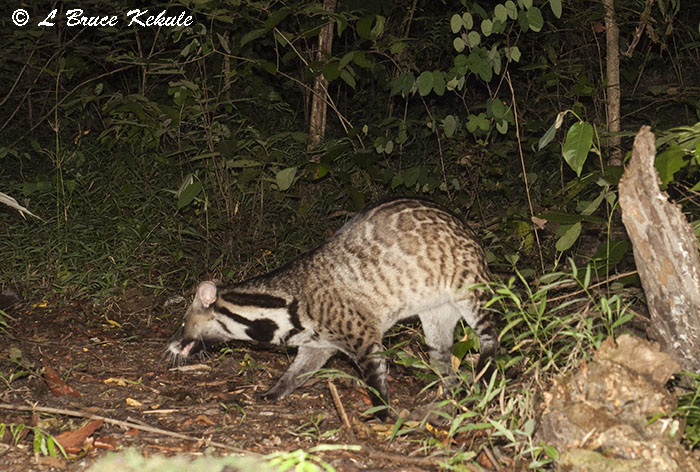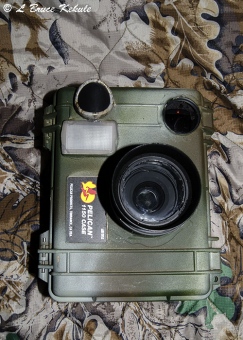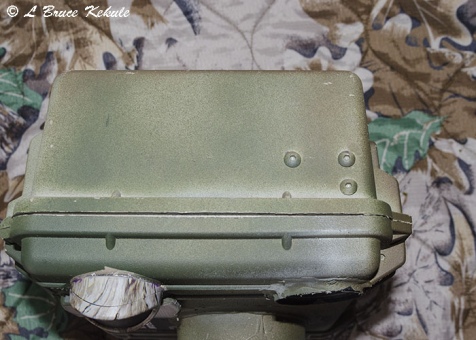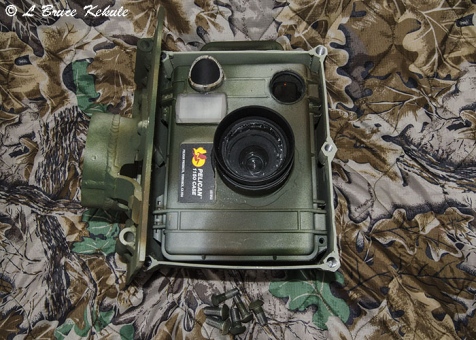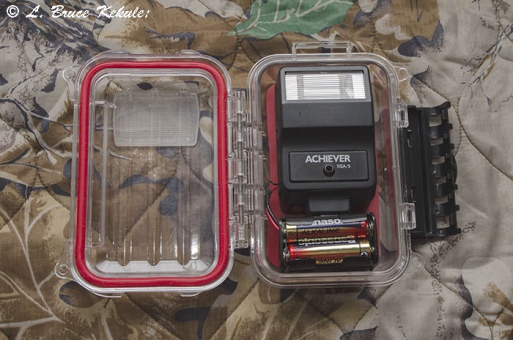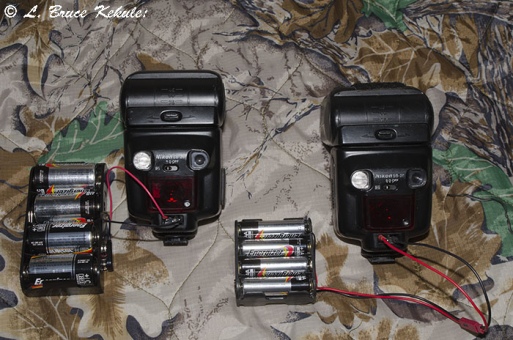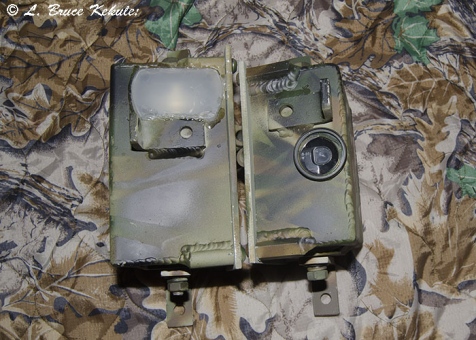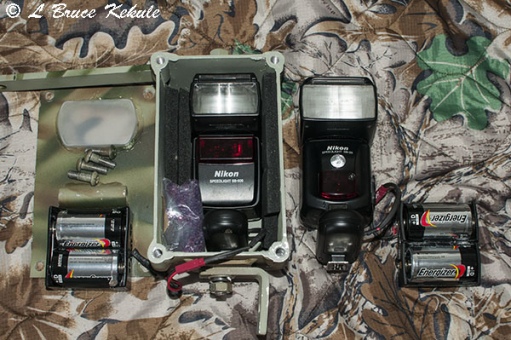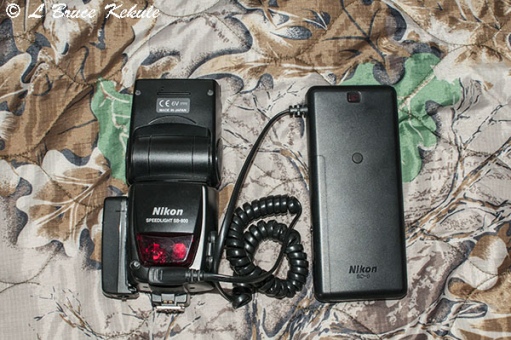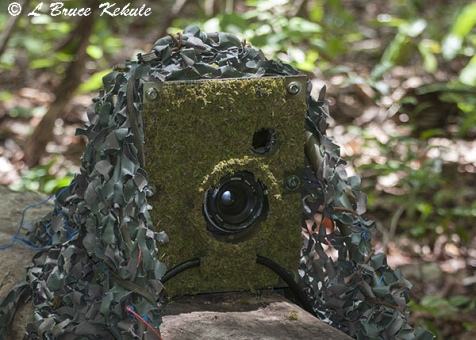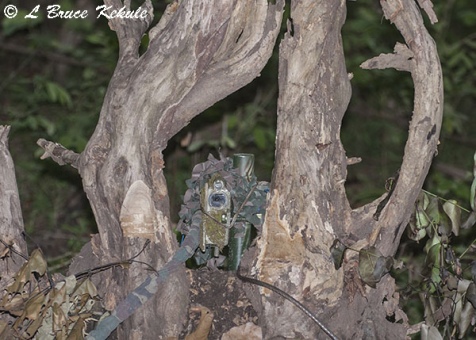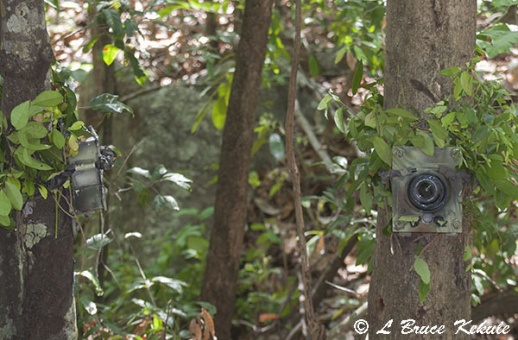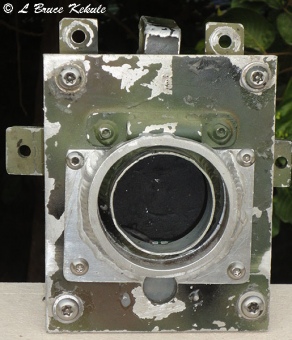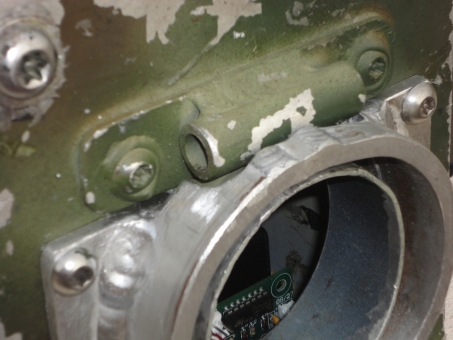Posts Tagged ‘infrared camera trap’
Nikon D90 DSLR trail cam catches a ‘Large Indian Civet’
The ‘Big Cat Trailhead’ has proven to be a real wildlife haven with loads of cats plus other carnivores walking past on almost a daily/nightly basis. Because of so much interaction, I decided to set-up my Nikon D90/SB400/Yeti/Plano 1460 case facing the other way opposite my Canon 400D.
The Yeti board was very old and not working too well. I tried to adjust distance and sensitivity but it still would only trip the cam from about a meter away. However, the cam did get one shot of a ‘Large Indian Civet’ shown here. The markings on this medium sized carnivore are unique and these creatures are very common in this forest.
I have since brought the cam home and replaced the board with a Snapshotsniper SSII #5 board and it is now ‘rocking and rolling’. Look forward to checking both cams in a couple of weeks and I’m confident there will be some interesting creatures walking past…! Enjoy.
Nikon D300s trail cam: A multi-purpose DSLR
A camera trap with two sensors and two flash systems
A Nikon D300s trail cam in a Pelican 1150.
My latest cam is probably the most versatile DSLR trail cam I have built so far specifically put together for the varied conditions and camera trap setups found in Thai forests. With fantastic opportunities for the big cats, wild cattle and other amazing creatures, I decided to build this unit for several reasons.
My choice of a Nikon D300s was three-fold: I found one in used condition at a fair price. I already had a Nikon ML-3 ‘Modulite Remote Control’ trigger that works with the Nikon D200 up to the D800 plus the pro-size Nikon bodies with the 10-pin plug. The D300s is a medium sized camera that just fits in a Pelican 1150 case that I also had. I prefer this size for most of my DSLR trail cams.
The Pelican 1150 opened showing internal components.
Another motive for the D300s was its ability to produce very little noise at high ISO settings. The cam has a Nikon ‘DX’ fixed 35mm ƒ1.8 lens and uses a MB-D10 battery grip with two EN-EL3e batteries. I will be starting out with ISO 400 and if I get too many dark daytime images, will go up a notch or two and probably stay at 800.
This unit has two sensors: the active infrared ML-3 and a passive infrared Snapshot Sniper SSII board that can be easily switched from one to the other. A special aluminum holder was made-up for the ML-3 receiver attached to the case with three 8/32” button head machine screws at the top on the right. The SSII was placed on the left over the flash.
The top end showing three screws holding the ML-3 receiver.
The ML-3 transmitter is housed in an ‘elephant proof’ aluminum box and has 10mm pivot bolts and L-plates. A laser pointer fits in the tube at the top to help in alignment and the box is adjustable for all angles. A 10mm ‘Python’ locking cable 10mm runs through a pipe welded to the faceplate.
ML-3 transmitter with the ‘laser pointer’ in an ‘elephant proof’ aluminum box.
There are two flash systems: a Nikon SB-400 with two AA externals and SC-17 sync cable (shortened) to fit upside-down next to the cam on the left, and to fire off on every shot tripping a Nikon SB-80 with two 4-pack AA externals (either new Eneloop or AA Lithium) with the flash set to remote. An ‘elephant proof’ box houses the SB-80 and battery packs with stainless steel 10mm pivot bolts, nuts, lock washers and L-plates and is adjustable for most angles. Another ‘Python’ cable secures the flash.
Slave flashes to be used with the D300s; Nikon SB-80 (right)
and National’ generic slave flash (left).
The other system is a PT-04NE FM Radio Speedlite trigger (transmitter and a couple receivers) mounted to an SB-80 and a SB-28 as slaves. I will explain my reason below for the ‘two in one’ system on both the sensors and flash. Another slave flash was built using a ‘National’ generic flash with two 2-pack AA externals for a total of eight AA batteries. A ‘Nissin’ flash trigger I had for more than a decade and recently found along with a ‘National’ sync cable to control the flash, works very well. This all fits nicely in a clear Pelican 1030 and I built my ‘elephant proof’ box as shown that is also adjustable.
Unfortunately, the Nikon ‘wireless flash system’ using the pop-up flash is not viable because the cam will only fire once (even in continuous mode) and then wait a second or two before tripping again. I need multiple shots in continuous mode (5-6 shots) to catch quick stepping animals more than once. The Nikon SB-600, 700, 800 or 900 can be tripped with the pop-up flash (line-of-sight) but it’s just too slow for this cam.
The reason I’m using a SB-400 is simple; it will fire on the first trigger and follow-up shots specially with AA Lithium batteries. It also has loads of power (better than the flip-up) to fill the frame and is TTL. A few remote slaves strategically placed will reduce ‘eye-shine’. I have made up a simple mirror system to direct light straight into the flash sensor as an experiment.
Experimental mirror to be angled directing light into the flash sensor
and attached to the tree above the flash unit.
The camera was a tight fit actually expanding the case a bit but after some serious sanding with a drum sander on both the case and cam, it now slips down nicely to the bottom and it closes easily. The sides of the case are slightly thinner but will not be a problem. However, a notch had to be cut for the shutter cable but that’s all.
The snorkel is thin aluminum tubing with a 77mm UV filter. The flash hole is covered with a shortened Nikon diffuser and the ‘ML-3 receiver’ is covered by a 40.5mm UV filter on the right, and the SSII and HPWA are fitted on the left. Marine ‘Goop’ is used on all ports.
D300s trail cam in an ‘elephant proof’ aluminum box.
As usual, an elephant proof box was made up for the cam to just fit and is installed on a tree using four 3” x 3/8” stainless lag bolts from inside the box. Four 12mm socket and two 10mm ‘power torque’ machines screws attach the faceplate and two 10mm (3/8”) ‘Python locking cables’ slip through pipes welded to the front for extra security. Camouflage paint in my usual ‘no two alike’ pattern. I will also be using dried moss glued on to the faceplate and sides of the box. Plastic leaves are wrapped around the box and locking cables to conceal everything.
The reason for the ‘two in one’ system: When there is heavy insect activity during the rainy season (now), large beetles, butterflies and moths will trip an active infrared sensor shooting an empty forest. I would use the passive infrared during this time. But during the dry season and for exact tripping, the ML-3 active infrared is more precise.
On the flash: some setups that can use light sensitive slave flashes, the SB-400 would be activated. Others sites that would require radio transmitted flash control due to tree or root placement, the radio trigger would be used. I can be selective on both systems and everything stays in the 1150.
I really look forward to setting this cam and will post the first set-up when done. Hope this helps those with ‘DSLR’ madness (like me). Just kidding…! Enjoy.
Nikon D90 DSLR camera trap: Almost a year in the making
A new DSLR camera trap
A Nikon D90 and battery pack with a 50mm ƒ 1.8, SB400 flash and a Yeticam board in a Plano 1460.
Last year in September, I made a post about a Nikon D90 with a 50mm ƒ1.8 lens and a SB-400 flash in conjunction with a Yeticam board in a Plano #1460 clear case.
It was in pieces at the time and sat on my bench until last month when I decided to finish it off. I have two sets but will test this one first to see the results. The SB-400 has four AA externals plus two in the flash for (six). I use either Lithiums or Enelopes.
D90 and an ‘Achiever’ slave flash in a Plano 1499.
The D90, battery pack and SB-400 sits nicely in the case but a relief hole was needed on the side to allow a little more room for the shutter cable. I found some ‘Meike N3’ electronic shutter release for Nikon (90 degree plug) and just cut the button off and attached the wires to a Yeti board. I used a piece of ‘plastic tubing’ and a 10 Baht coin and ‘gooped’ it all in sealing the tube.
D90 in an aluminum ‘elephant proof’ box.
A 3” X 2.8” X 1/8” aluminum tube is used for the snorkel and a 77mm filter is gooped on. No other modifications are made to the case and everything fits perfectly. The Yeticam board is set in the vertical position and an EOS chip was installed.
Achiever slave flash and ‘AA’ externals.
A huge ‘elephant proof’ aluminum box was made up to protect the cam. As this one is really large, I had my welder attach a plate on top at a 45-degree angle to keep the jumbos at bay by not allowing them to get a grip on the top.
Nikon SB-26s with ‘C’ and ‘AA’ externals.
Four 3” X 3/8 stainless lag bolts set the cam tightly on a large tree and I can use two 10mm (3/8”) Python locking cables for extra security.
SB-26s and externals in ‘elephant proof’ boxes.
In the meantime, I added two Nikon SB-26s with 6-volt externals in ‘elephant proof’ aluminum boxes run as slaves. The flashes were modified to take straight 6-volt packs and plugged into the pos. and neg. pins as shown. Real Nikon battery packs cost a fortune. This is an alternative that works very well.
The ‘elephant proof’ boxes were made for the SB-26s that have flash diffusers gooped on the front and 40.5mm UV filters on the back in line with the light sensor.
SB-26s slaves showing diffuser and 40.5mm UV filter.
I also built a small ‘Achiever’ slave flash with 4-AA externals in a clear Plano 1499 case. An old 1020 ‘elephant proof’ box was recycled for this flash. This will be used depending on some locations.
D90 in an ‘elephant proof’ box ready for the field.
I look forward to setting this cam and slaves. I probably will put it close to where I was charged by that bull gaur.
Nikon SB-600/SB-800-900/SB-28 DSLR slave flash
Nikon remote flashes
Nikon SB-600 (middle), SB-800 (left) and SB-28 (right) remote flashes.
After installing and testing my D700 trail cam with several remote SB-28 flashes in the forest, it was apparent I needed another flash closer to the cam on the right side of the fallen tree to eliminate the shadow.
I had an old SB-600 that has been one of my mainstay flashes for some time and since I don’t shoot much flash now, thought I would regulate this one to camera trap duty.
SB-600 and SB-28 with Yongnuo Wireless flash triggers and ‘D’ cell externals.
I will be setting this flash with four brand-new ‘Enelope’ rechargeable batteries to see how long they will last on standby.
A Yongnue 602n wireless flash trigger and two ‘D’ cell externals is used and the assembly is housed in one of my ‘elephant proof’ aluminum boxes. I have now tested the ‘D’ cells and getting more than a month on stand-by…!
‘D’ cells in place.
On this box, I beefed-up the ends and drilled and tapped for 10mm machine screws and set with epoxy to act as pivots, and a ‘L’ bracket on the bottom and a 1” x ¼” x 14” aluminum strap across the top of the log. I can aim the flash straight at the trail and lock it in place. A generic flash diffuser is shortened to about 1/4″ and then ‘Goop’ is applied after camouflage painting.
By using two or three 3” x 3/8” stainless lag bolts, the flash will be tight, and elephants or bears would have hard time breaking these flashes. However, a bear-tooth through the diffuser could be a problem. Of course the proof is in the pudding and we shall see because the big elephant herd will come through one day, and they will surely have a go at destroying the whole set…!
SB-800 with an extra AA battery pack (5 AA cells).
In this box, I can also use a Nikon SB-28 flash that has a great stand-by feature, and is fairly cheap and readily available on the second hand camera market. A SB-800/900 can also be used.
I’m also working on a couple of SB-800s that will have extra Nikon battery packs (5-AAs) set to remote plus the 6-pack. During testing, they work extremely well but are still not TTL. Still working on that. Hope this helps those who need some tough slave flashes for your DSLR trail cam.
SB-800 with Nikon 6-AA battery pack.
Nikon D700 and Canon 350D trail cams on location
Nikon and Canon DSLR trail cams
Nikon D700 camera trap installed on a fallen tree trunk.
Set-up my Nikon D700 and Canon 350D at two locations in Huai Kha Khaeng that are frequented by tigers and leopards, plus many other Asian animals like elephant, gaur, banteng and more. Both cams trigger in continuous mode (three to four shots per actuation).
Nikon D700 camera trap with moss and old leaf camouflage.
The D700 was attached to a fallen tree with six legs bolted down with 3” x 3/8” stainless lag bolts. The transmitter was installed on an aluminum pole pounded into the ground and hidden in the tree roots.
Nikon ML-3 active infrared transmitter in aluminum box.
The Canon 350D was bolted to a standing tree with four lag bolts. Python cables secure both cams and the transmitter to the tree. They are both solid and if an elephant can move the tree, they can move the cams.
Canon 350D and flash installed on a tree next to a wildlife trail.
The Nikon has three flashes set off by ‘YongNuo’ wireless flash triggers with ‘D’ cell externals and three Nikon SB28s. The flashes trigger on the second shot.
Canon 350D beefed-up snorkel.
The Canon has only two flashes (Canon 270EXs) at the moment and this cam triggers them with the ‘YongNuo’ on the second shot too. A third Canon flash is in for repair after some ‘D’ cells leaked and left some residue in the box. I have beefed-up the snorkel as shown here and this should keep the elephants at bay.
Canon 350D beefed-up snorkel – close up.
I’m using four AA ‘Energizer’ Lithium batteries as power in the flashes and we’ll see how long they can last. The next job would be to add externals or ‘flash battery packs’ if the Lithium batteries are not enough for a month’s soak. I’ll be checking the Nikon and the Canon on May 17th and post something after that.


